Healthcare Management: Change Management Report for University
VerifiedAdded on 2023/06/10
|5
|1268
|435
Report
AI Summary
This report delves into the realm of change management within healthcare settings. It begins by defining change management as a systematic approach to transforming organizational goals, procedures, and technologies. The report emphasizes the crucial role of change management in healthcare for improving performance, adapting to new technologies, and addressing key issues. It highlights the importance of employee adaptation and the role of leaders in clarifying the vision, connecting with employees, and acting as role models. The objectives of change management, including establishing a culture of innovation and developing innovative strategies, are discussed. The report also examines the various impacts of change management, including initial reactions, the need for new skills, and the potential for employee morale issues. It concludes by stressing the importance of careful planning to mitigate negative impacts and promote positive outcomes such as increased efficiency and productivity. The report also includes references to support the claims made in the assignment.
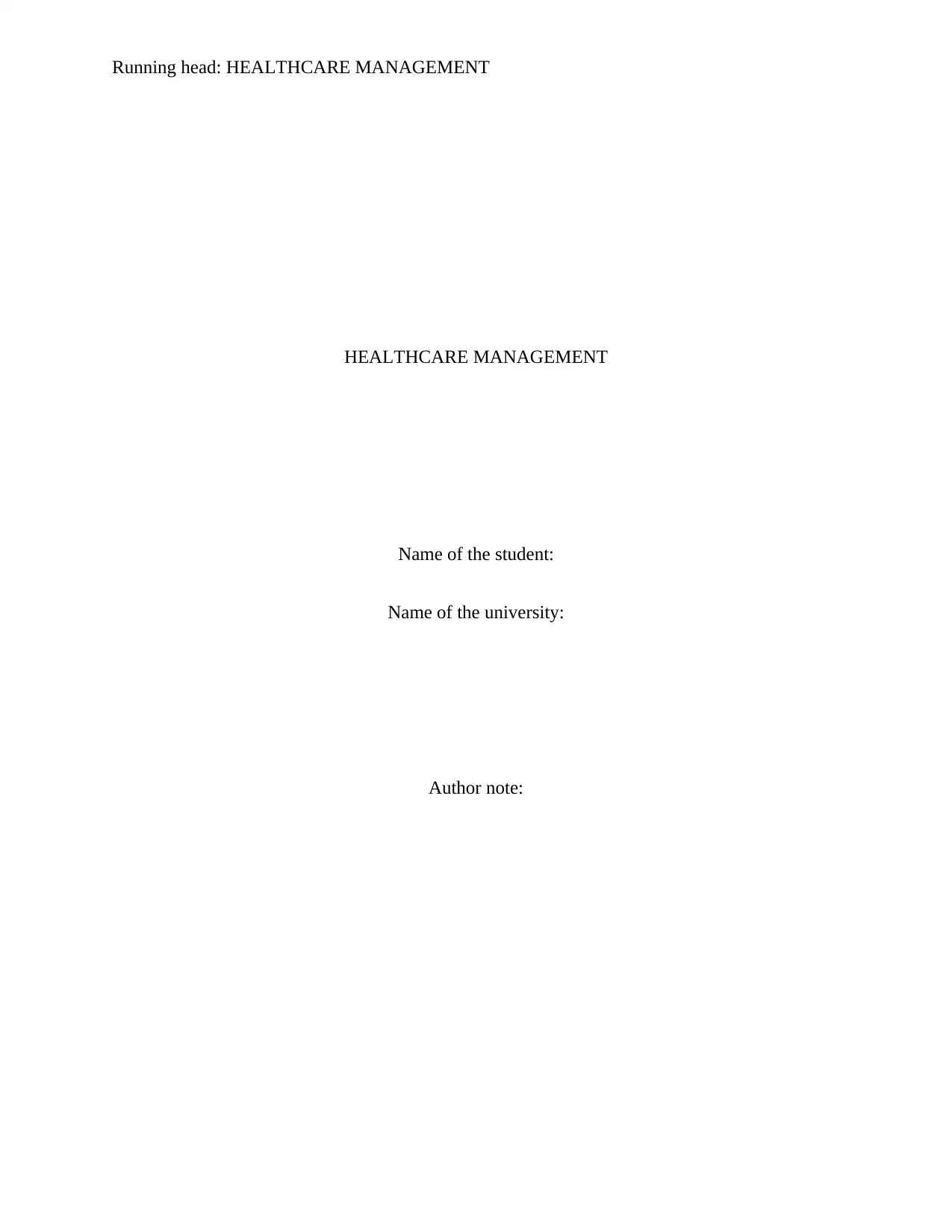
Running head: HEALTHCARE MANAGEMENT
HEALTHCARE MANAGEMENT
Name of the student:
Name of the university:
Author note:
HEALTHCARE MANAGEMENT
Name of the student:
Name of the university:
Author note:
Paraphrase This Document
Need a fresh take? Get an instant paraphrase of this document with our AI Paraphraser
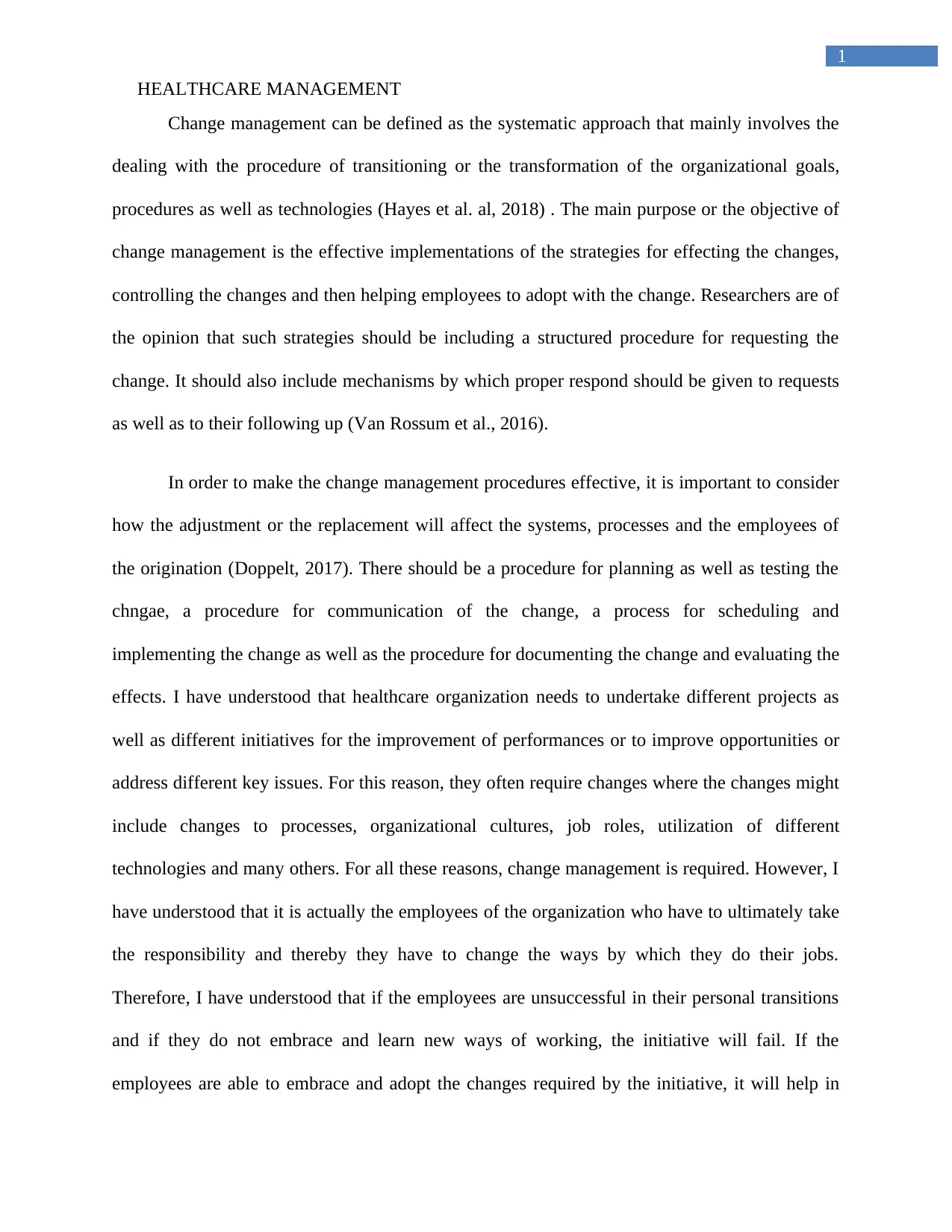
1
HEALTHCARE MANAGEMENT
Change management can be defined as the systematic approach that mainly involves the
dealing with the procedure of transitioning or the transformation of the organizational goals,
procedures as well as technologies (Hayes et al. al, 2018) . The main purpose or the objective of
change management is the effective implementations of the strategies for effecting the changes,
controlling the changes and then helping employees to adopt with the change. Researchers are of
the opinion that such strategies should be including a structured procedure for requesting the
change. It should also include mechanisms by which proper respond should be given to requests
as well as to their following up (Van Rossum et al., 2016).
In order to make the change management procedures effective, it is important to consider
how the adjustment or the replacement will affect the systems, processes and the employees of
the origination (Doppelt, 2017). There should be a procedure for planning as well as testing the
chngae, a procedure for communication of the change, a process for scheduling and
implementing the change as well as the procedure for documenting the change and evaluating the
effects. I have understood that healthcare organization needs to undertake different projects as
well as different initiatives for the improvement of performances or to improve opportunities or
address different key issues. For this reason, they often require changes where the changes might
include changes to processes, organizational cultures, job roles, utilization of different
technologies and many others. For all these reasons, change management is required. However, I
have understood that it is actually the employees of the organization who have to ultimately take
the responsibility and thereby they have to change the ways by which they do their jobs.
Therefore, I have understood that if the employees are unsuccessful in their personal transitions
and if they do not embrace and learn new ways of working, the initiative will fail. If the
employees are able to embrace and adopt the changes required by the initiative, it will help in
HEALTHCARE MANAGEMENT
Change management can be defined as the systematic approach that mainly involves the
dealing with the procedure of transitioning or the transformation of the organizational goals,
procedures as well as technologies (Hayes et al. al, 2018) . The main purpose or the objective of
change management is the effective implementations of the strategies for effecting the changes,
controlling the changes and then helping employees to adopt with the change. Researchers are of
the opinion that such strategies should be including a structured procedure for requesting the
change. It should also include mechanisms by which proper respond should be given to requests
as well as to their following up (Van Rossum et al., 2016).
In order to make the change management procedures effective, it is important to consider
how the adjustment or the replacement will affect the systems, processes and the employees of
the origination (Doppelt, 2017). There should be a procedure for planning as well as testing the
chngae, a procedure for communication of the change, a process for scheduling and
implementing the change as well as the procedure for documenting the change and evaluating the
effects. I have understood that healthcare organization needs to undertake different projects as
well as different initiatives for the improvement of performances or to improve opportunities or
address different key issues. For this reason, they often require changes where the changes might
include changes to processes, organizational cultures, job roles, utilization of different
technologies and many others. For all these reasons, change management is required. However, I
have understood that it is actually the employees of the organization who have to ultimately take
the responsibility and thereby they have to change the ways by which they do their jobs.
Therefore, I have understood that if the employees are unsuccessful in their personal transitions
and if they do not embrace and learn new ways of working, the initiative will fail. If the
employees are able to embrace and adopt the changes required by the initiative, it will help in
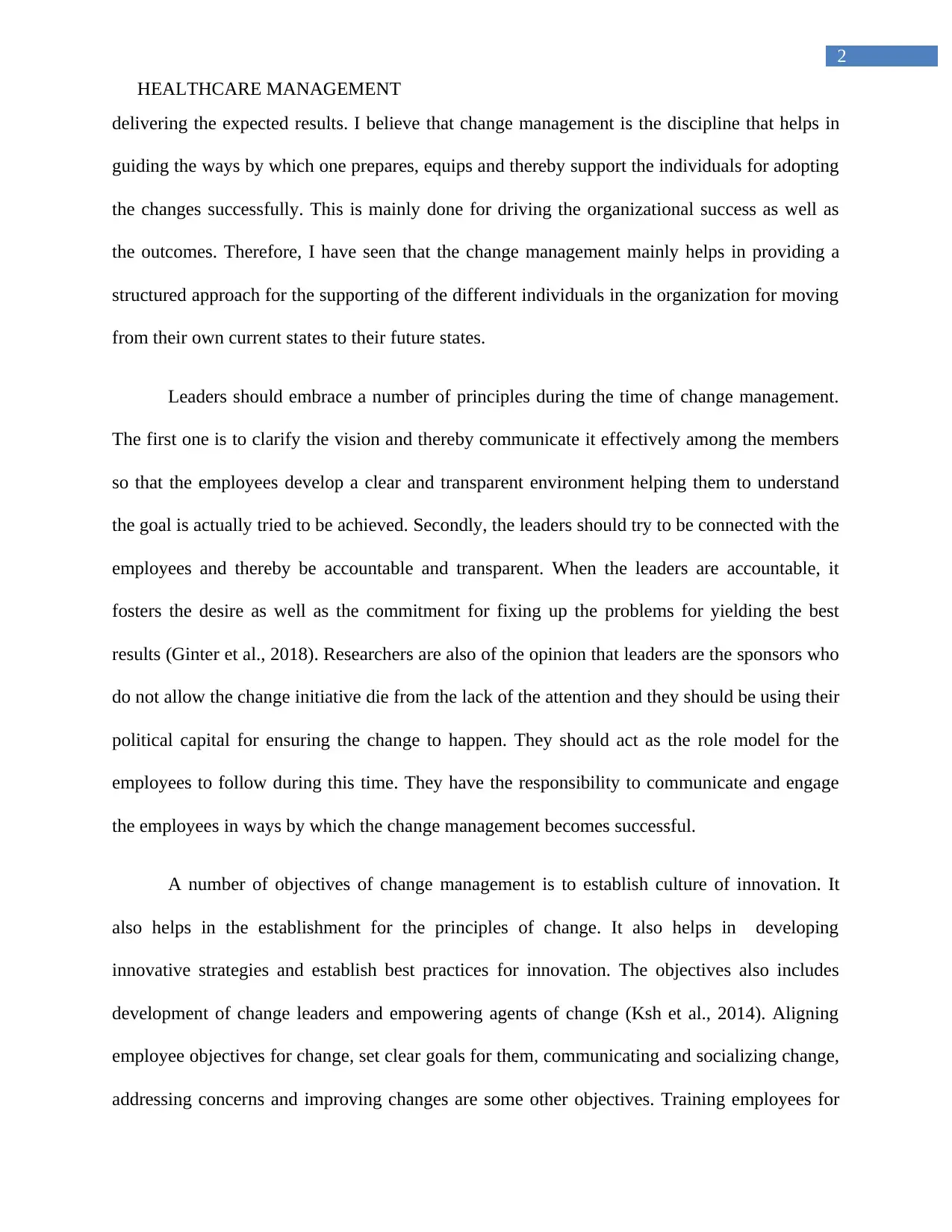
2
HEALTHCARE MANAGEMENT
delivering the expected results. I believe that change management is the discipline that helps in
guiding the ways by which one prepares, equips and thereby support the individuals for adopting
the changes successfully. This is mainly done for driving the organizational success as well as
the outcomes. Therefore, I have seen that the change management mainly helps in providing a
structured approach for the supporting of the different individuals in the organization for moving
from their own current states to their future states.
Leaders should embrace a number of principles during the time of change management.
The first one is to clarify the vision and thereby communicate it effectively among the members
so that the employees develop a clear and transparent environment helping them to understand
the goal is actually tried to be achieved. Secondly, the leaders should try to be connected with the
employees and thereby be accountable and transparent. When the leaders are accountable, it
fosters the desire as well as the commitment for fixing up the problems for yielding the best
results (Ginter et al., 2018). Researchers are also of the opinion that leaders are the sponsors who
do not allow the change initiative die from the lack of the attention and they should be using their
political capital for ensuring the change to happen. They should act as the role model for the
employees to follow during this time. They have the responsibility to communicate and engage
the employees in ways by which the change management becomes successful.
A number of objectives of change management is to establish culture of innovation. It
also helps in the establishment for the principles of change. It also helps in developing
innovative strategies and establish best practices for innovation. The objectives also includes
development of change leaders and empowering agents of change (Ksh et al., 2014). Aligning
employee objectives for change, set clear goals for them, communicating and socializing change,
addressing concerns and improving changes are some other objectives. Training employees for
HEALTHCARE MANAGEMENT
delivering the expected results. I believe that change management is the discipline that helps in
guiding the ways by which one prepares, equips and thereby support the individuals for adopting
the changes successfully. This is mainly done for driving the organizational success as well as
the outcomes. Therefore, I have seen that the change management mainly helps in providing a
structured approach for the supporting of the different individuals in the organization for moving
from their own current states to their future states.
Leaders should embrace a number of principles during the time of change management.
The first one is to clarify the vision and thereby communicate it effectively among the members
so that the employees develop a clear and transparent environment helping them to understand
the goal is actually tried to be achieved. Secondly, the leaders should try to be connected with the
employees and thereby be accountable and transparent. When the leaders are accountable, it
fosters the desire as well as the commitment for fixing up the problems for yielding the best
results (Ginter et al., 2018). Researchers are also of the opinion that leaders are the sponsors who
do not allow the change initiative die from the lack of the attention and they should be using their
political capital for ensuring the change to happen. They should act as the role model for the
employees to follow during this time. They have the responsibility to communicate and engage
the employees in ways by which the change management becomes successful.
A number of objectives of change management is to establish culture of innovation. It
also helps in the establishment for the principles of change. It also helps in developing
innovative strategies and establish best practices for innovation. The objectives also includes
development of change leaders and empowering agents of change (Ksh et al., 2014). Aligning
employee objectives for change, set clear goals for them, communicating and socializing change,
addressing concerns and improving changes are some other objectives. Training employees for
⊘ This is a preview!⊘
Do you want full access?
Subscribe today to unlock all pages.

Trusted by 1+ million students worldwide
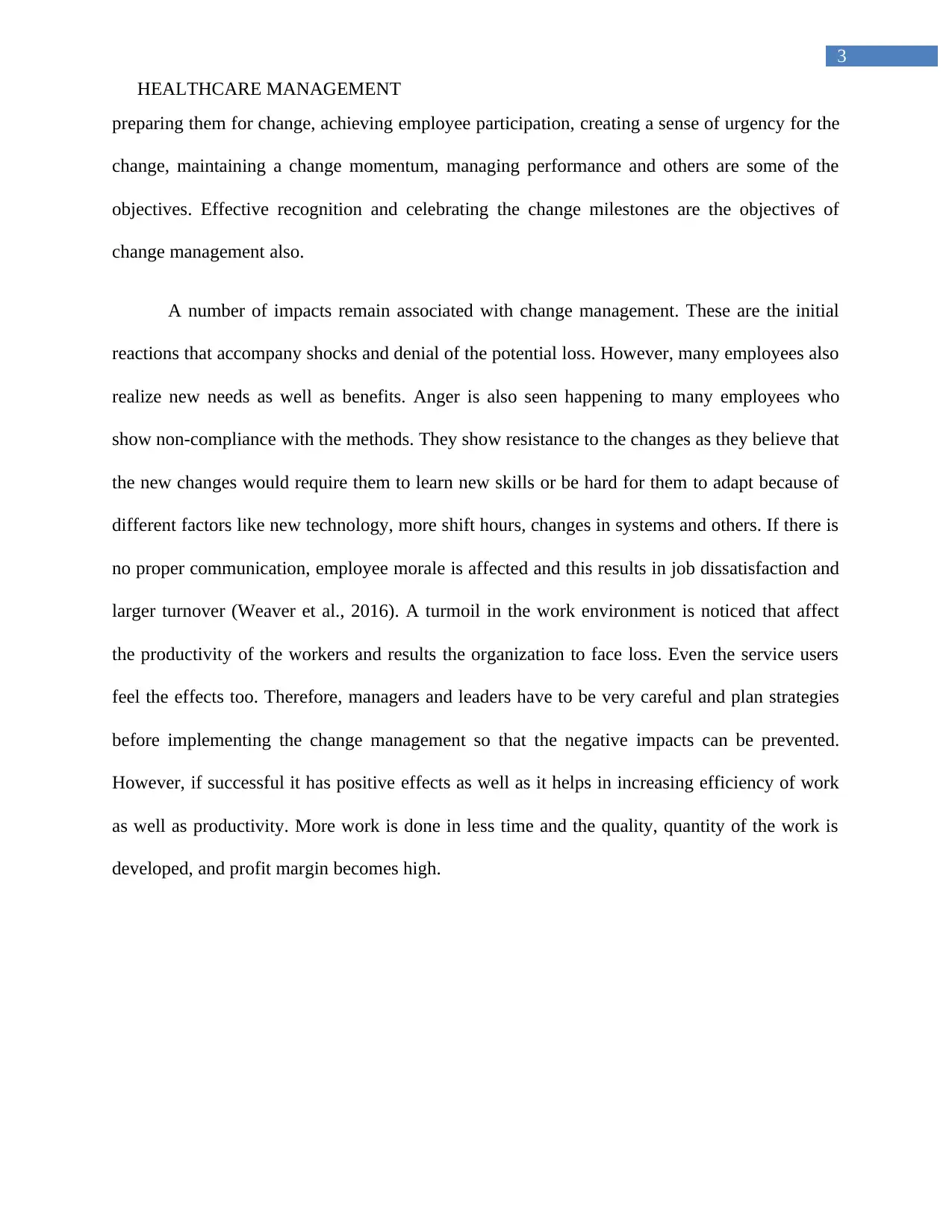
3
HEALTHCARE MANAGEMENT
preparing them for change, achieving employee participation, creating a sense of urgency for the
change, maintaining a change momentum, managing performance and others are some of the
objectives. Effective recognition and celebrating the change milestones are the objectives of
change management also.
A number of impacts remain associated with change management. These are the initial
reactions that accompany shocks and denial of the potential loss. However, many employees also
realize new needs as well as benefits. Anger is also seen happening to many employees who
show non-compliance with the methods. They show resistance to the changes as they believe that
the new changes would require them to learn new skills or be hard for them to adapt because of
different factors like new technology, more shift hours, changes in systems and others. If there is
no proper communication, employee morale is affected and this results in job dissatisfaction and
larger turnover (Weaver et al., 2016). A turmoil in the work environment is noticed that affect
the productivity of the workers and results the organization to face loss. Even the service users
feel the effects too. Therefore, managers and leaders have to be very careful and plan strategies
before implementing the change management so that the negative impacts can be prevented.
However, if successful it has positive effects as well as it helps in increasing efficiency of work
as well as productivity. More work is done in less time and the quality, quantity of the work is
developed, and profit margin becomes high.
HEALTHCARE MANAGEMENT
preparing them for change, achieving employee participation, creating a sense of urgency for the
change, maintaining a change momentum, managing performance and others are some of the
objectives. Effective recognition and celebrating the change milestones are the objectives of
change management also.
A number of impacts remain associated with change management. These are the initial
reactions that accompany shocks and denial of the potential loss. However, many employees also
realize new needs as well as benefits. Anger is also seen happening to many employees who
show non-compliance with the methods. They show resistance to the changes as they believe that
the new changes would require them to learn new skills or be hard for them to adapt because of
different factors like new technology, more shift hours, changes in systems and others. If there is
no proper communication, employee morale is affected and this results in job dissatisfaction and
larger turnover (Weaver et al., 2016). A turmoil in the work environment is noticed that affect
the productivity of the workers and results the organization to face loss. Even the service users
feel the effects too. Therefore, managers and leaders have to be very careful and plan strategies
before implementing the change management so that the negative impacts can be prevented.
However, if successful it has positive effects as well as it helps in increasing efficiency of work
as well as productivity. More work is done in less time and the quality, quantity of the work is
developed, and profit margin becomes high.
Paraphrase This Document
Need a fresh take? Get an instant paraphrase of this document with our AI Paraphraser
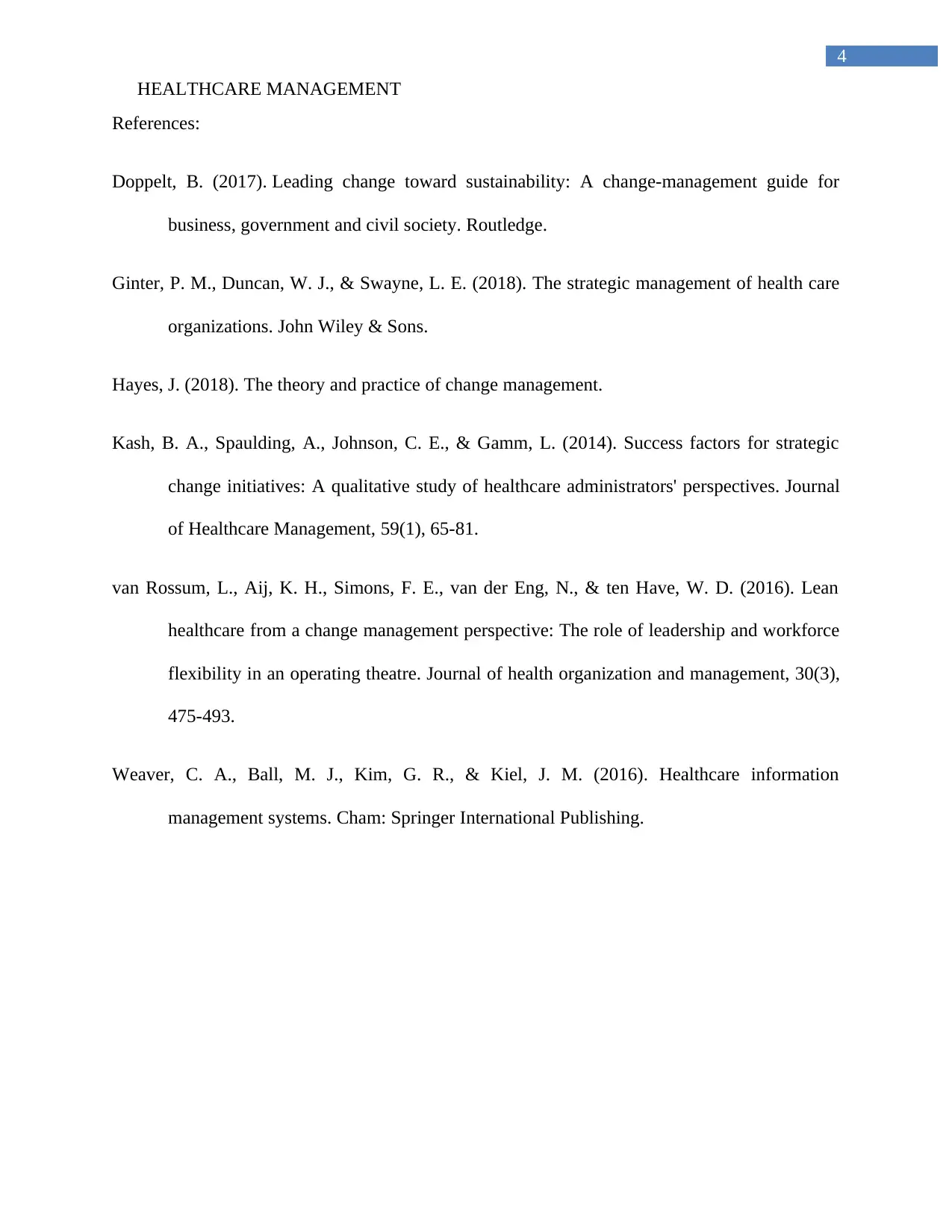
4
HEALTHCARE MANAGEMENT
References:
Doppelt, B. (2017). Leading change toward sustainability: A change-management guide for
business, government and civil society. Routledge.
Ginter, P. M., Duncan, W. J., & Swayne, L. E. (2018). The strategic management of health care
organizations. John Wiley & Sons.
Hayes, J. (2018). The theory and practice of change management.
Kash, B. A., Spaulding, A., Johnson, C. E., & Gamm, L. (2014). Success factors for strategic
change initiatives: A qualitative study of healthcare administrators' perspectives. Journal
of Healthcare Management, 59(1), 65-81.
van Rossum, L., Aij, K. H., Simons, F. E., van der Eng, N., & ten Have, W. D. (2016). Lean
healthcare from a change management perspective: The role of leadership and workforce
flexibility in an operating theatre. Journal of health organization and management, 30(3),
475-493.
Weaver, C. A., Ball, M. J., Kim, G. R., & Kiel, J. M. (2016). Healthcare information
management systems. Cham: Springer International Publishing.
HEALTHCARE MANAGEMENT
References:
Doppelt, B. (2017). Leading change toward sustainability: A change-management guide for
business, government and civil society. Routledge.
Ginter, P. M., Duncan, W. J., & Swayne, L. E. (2018). The strategic management of health care
organizations. John Wiley & Sons.
Hayes, J. (2018). The theory and practice of change management.
Kash, B. A., Spaulding, A., Johnson, C. E., & Gamm, L. (2014). Success factors for strategic
change initiatives: A qualitative study of healthcare administrators' perspectives. Journal
of Healthcare Management, 59(1), 65-81.
van Rossum, L., Aij, K. H., Simons, F. E., van der Eng, N., & ten Have, W. D. (2016). Lean
healthcare from a change management perspective: The role of leadership and workforce
flexibility in an operating theatre. Journal of health organization and management, 30(3),
475-493.
Weaver, C. A., Ball, M. J., Kim, G. R., & Kiel, J. M. (2016). Healthcare information
management systems. Cham: Springer International Publishing.
1 out of 5
Related Documents
Your All-in-One AI-Powered Toolkit for Academic Success.
+13062052269
info@desklib.com
Available 24*7 on WhatsApp / Email
![[object Object]](/_next/static/media/star-bottom.7253800d.svg)
Unlock your academic potential
Copyright © 2020–2025 A2Z Services. All Rights Reserved. Developed and managed by ZUCOL.





